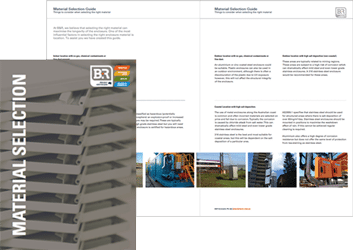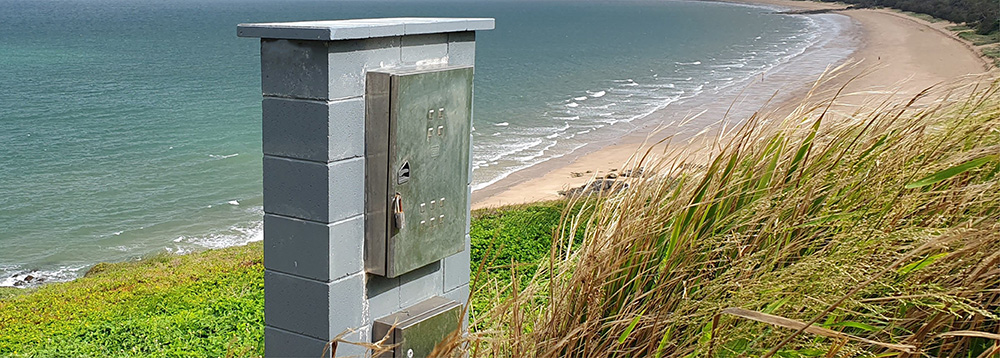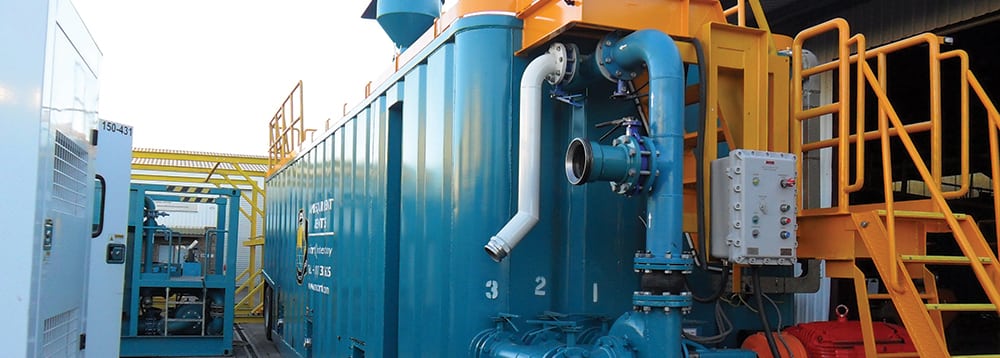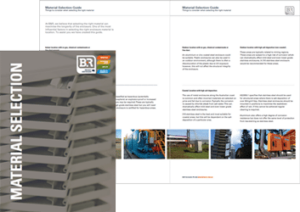Material Selection Guide
Things to consider when selecting the right material
Enclosure Materials
B&R Enclosures supply a wide range of enclosures in different enclosure materials. There are various reasons why you would choose one material over another and a brief summary is provided below.
Please note that specific site conditions can significantly influence the choice of enclosure materials. The best way to select the right material is to look at the performance of similar materials on site. As such the following are general guidelines only.
Steel
Steel can be used for applications where there is little chance of corrosion or in locations where the enclosure will become scratched or damaged. Steel enclosures are strong and robust, but steel can be susceptible to corrosion from the environment once the powdercoated surface is damaged.
Aluminium
Powdercoated aluminium can be considered as the next step up for resistance to corrosion. It is substantially better as resistance to salt water, although in many cases should not be used for applications where strong alkalis might be present.
Aluminium is a great choice for applications in remote locations due to this higher corrosion resistance and its lighter weight which enables it to be manually installed rather than machine lifted in many applications.
Stainless Steel
B&R manufacture a range of enclosures from 316 grade stainless and offers excellent resistance to salt water and other forms of environmental corrosion. These tend to outlast enclosures in any other materials. The use of 316 stainless steel is also aesthetically pleasing.
B&R use a special N4 surface finish that helps minimise corrosion and provides a great ‘brushed metal’ look.
Plastics
Used for enclosures with few requirements and for resistance to corrosion that would be problematic for metal enclosures. Plastic enclosures are a versatile choice. The disadvantage is that they are not as strong as metal enclosures and cannot be built to anywhere near all the sizes required for industry. They can also be susceptible to damage from the sun.
More Detail on Material Options
Indoor location with no gas, chemical contaminants or fine dust present.
Generally any enclosure material would be suitable –– an enclosure choice would be based more on the type of equipment going inside and the IP rating (protection from dust and water ingress) rather than the material used. Base on cost, the most appropriate material would
be plastic or zinc coated steel.
Indoor location with gas, chemical contaminants or fine dust.
If the location is exposed to gas or other chemical contaminants 316 stainless steel is generally suitable however, chemicals can react differently to various materials. If the enclosure is exposed to fine dust 316 stainless steel would be the most suitable option to avoid possible corrosion.
If the area is classified as hazardous (potentially explosive atmosphere) an explosion-proof or increased safety enclosure may be required. These are typically made from high grade stainless steel but you will need to ensure the enclosure is certified for hazardous areas.
Outdoor location with no gas, chemical contaminants or fine dust.
An aluminium or zinc coated steel enclosure could be suitable. Plastic enclosures can also be used in an outdoor environment, although there is often a discolouration of the plastic due to UV exposure however, this will not affect the structural integrity of the enclosure.
Outdoor location with high salt deposition (non-coastal).
These areas are typically related to mining regions. These areas are subject to a high risk of corrosion which can dramatically affect mild steel and even lower grade stainless enclosures. A 316 stainless steel enclosure would be recommended for these areas.
Coastal Location with high salt deposition.
The use of metal enclosures along the Australian coast is common and often incorrect materials are selected on price and fail due to corrosion. Typically the corrosion is caused by chloride attack from salt water. This can dramatically affect mild steel and even lower grade
stainless steel enclosures.
316 stainless steel is the best and most suitable for coastal areas, but this will be dependent on the salt deposition of a particular area.
AS2699.1 specifies that stainless steel should be used for structured areas where there is salt deposition of over 60mg/m2/day. Stainless steel enclosures should be mounted in positions to maximise the washdown effect of rain. If this cannot be achieved regular cleaning is required.
Aluminium also offers a high degree of corrosion resistance but does not offer the same level of protection from tea-staining as stainless steel.
What materials we use
At B&R, we choose only the best materials when manufacturing our enclosures. This superior quality ensures you can trust the product and us.
316 Stainless Steel
The main benefits of using stainless steel are its structural strength, aesthetic appeal and high level of corrosion protection due to naturally occurring chromium-rich oxide film formed on the surface of the steel.
Grade 316 stainless steel can be used successfully in coastal locations where many other grades
may experience corrosion due to the higher levels of chloride present in the environment. It is also the preferred material used in food processing applications, it can be easily cleaned and resists many organic chemicals, dyes and a wide variety of inorganic chemicals.
B&R Enclosures use only the highest quality 316 stainless steel materials, manufacturing and finishing techniques and are accredited by the Australian Stainless Steel Development Association (ASSDA). For more details on ASSDA visit www.assda.asn.au.
Surface Finish
We finish our stainless steel products in a way that is aesthetically pleasing and also ensures superior protection. We apply an N4 surface finish, with a maximum Ra or 0.4μm. This Ra rating is a key factor in the corrosion protection and ‘cleanability’ of our products.
Surface corrosion, often referred to as ‘tea staining’ is common along the coast fringe and high salinity areas of Australia. Tea staining is a discolouration of the metal surface which is unsightly, but does not affect the structural integrity of the enclosure.
For more details on tea staining visit www.brenclosures.com.au/PDFs/Tea Staining.pdf
Zinc Coated Steel
We use primarily zinc coated steel for our B&R branded products. This is a matte, hot dipped, zinc iron alloy which when combined with chemical pretreatment and powdercoat finish offers the best possible corrosion protection for enclosure systems.
Pretreatment
A B&R branded zinc coated steel enclosure is punched, bent, welded and ground on the way through our factory. Following fabrication it goes through an automated process which consists of the following:
- Alkaline cleaner
- Reticulated freshwater rinse
- Iron phosphate coating
- Reticulated freshwater rinse
- Demineralised water with polymer additive
Titration tests are also conducted to ensure that the material meets the required specifications.
Powdercoat Finish
The powdercoat paint is applied at an average coating thickness of 100μm for a ripple finish and 70μm for a gloss. The minimum coating thickness is 60μm on the exterior of the enclosure and 25μm on the interior (conforms to AS/NZS 4506:1998).
Testing
The powdercoat paint finish is tested extensively to the following standards ensures consistent paint finish in terms of both quality and colour across our range of enclosures.
- Powdercoating thickness test (AS1580.108.1:1994)
- Cure Test, solvent resistance method (AS/NZS4506:1998)
- Adhesion, cross cut test (AS/NZS 1580.408.4:1993)
- Paint colour comparison test (AS2700:1996)
Material Selection Guide
This brochure is a guide to assist when choosing the best material for an electrical enclosure. Download
Tea Staining on Stainless Steel Products
Tea staining of stainless steels is a phenomenon that occurs where water with a significant chloride content is in regular contact with the metal surface. Download





